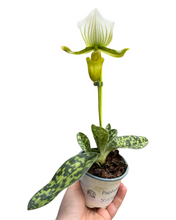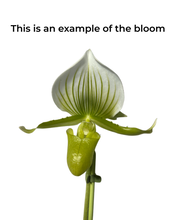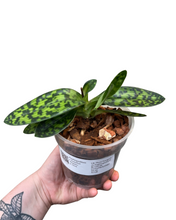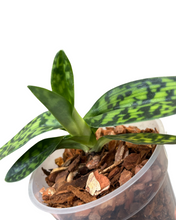Paphiopedilum is part of the Ochidaceae family and the native range of this genus is S. China to Tropical Asia. They are divided into two cultural groups: the warm-growing, mottled-leaved types like this one and the cool-growing, green-leaved types. These orchids are often called ‘Slipper Orchids’ due to the labellum (lip) which is pouch shaped and used to attract pollinators.
Paphiopedilum are typically terrestrial and sympodial without a pseudobulb, instead forming fans of six or more leaves; leaves are stiff, waxy or leathery and range from a glossy green to beautifully mottled. They produce an erect stem, bearing one flower. This plant is an artificial hybrid of P. callosum × P. lawrenceanum. The labellum is yellow-green and the upper petals are white with green stripes
Genus name is derived from the Greek Paphos (a city with a temple dedicated to Venus) and pedilon (shoe or slipper). Maudiae honours botanist Stephen Troyte Dunn’s wife Maud Dunn.
Light: Position your Paphiopedilum so it can see the sun for between 0-4 hours per day, this ought to include a period of direct light in the morning (being in line with the sun) followed by a partially obstructed view (through a translucent curtain or trees). If you are using a light meter, measurements of 800-1000 foot candles are ideal for optimal growth. Move plants back from the window at the height of the midday sun or, ideally, grow them behind a shade curtain.
Water: Paphiopedilum don’t have pseudobulbs so require more regular watering as they rely on the potting medium for water. Using lukewarm water, water the plants early in the day so the foliage will be dry before the temperatures drop at night.
Potting mix: A fairly porous mix is recommended, consisting of pine bark, some coco coir, perlite and horticultural charcoal. This mix provides support for the roots while allowing them to breathe and resist becoming water-logged.
You can repot and divide your Paphiopedilum every 1-2 years; with a clean tool, snip off any dead roots, then position the plant in the new container and fill around the roots with the potting mix until it reaches slightly over the base of the plant. It is important to not bury the new plant growths as this will lead to rotting. The base of each growth should be in contact with the growing medium to encourage new roots to form. Keep watering to a minimum until evidence of new growth is apparent but do not neglect the humidity or the plants will dehydrate, you could use a cloche or clear plastic bag to increase humidity. Keep recently repotted Paphiopedilum in a shady area and gradually move into the correct light conditions once new growth begins.
Fertilising: Plants growing in bark need a high nitrogen fertiliser (30-10-20 or 30-10-10 ratio) at half the strength recommended on the pack. Feed every 2 waterings, remembering to flush occasionally to prevent build up of salts.
Temperature: Warm-growing; day-time temperatures 23-26˚C and night-time temperature 15-18˚C.
Humidity: Moderate humidity, 40-50%.
Blooming information: Blooming typically occurs mid-autumn onwards although variations occur due to cultivation. Paphiopedilum produce one bloom per spike and last between 6 and 8 weeks, when the spike turns brown, cut close to the base of the plant. Cool nights are required once blooming has finished in order to encourage them to set buds for the next flowering.
Paphiopedilum are non-toxic.







